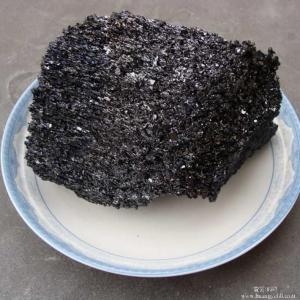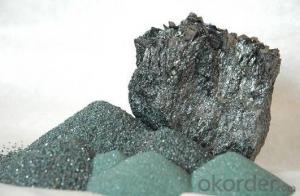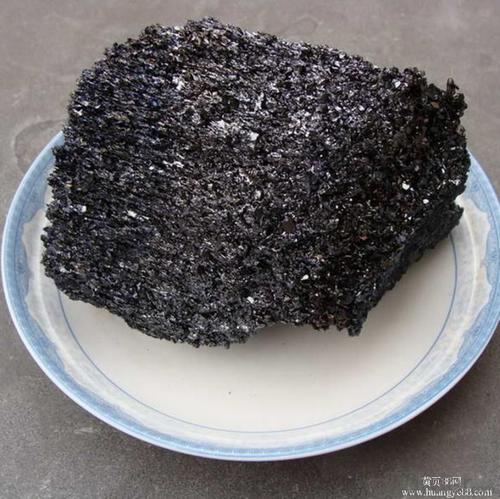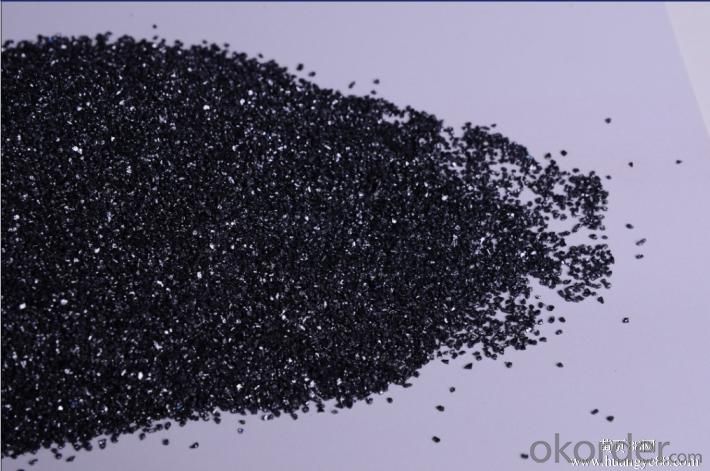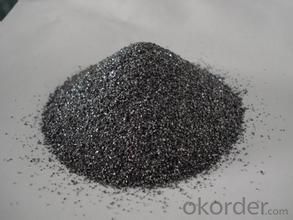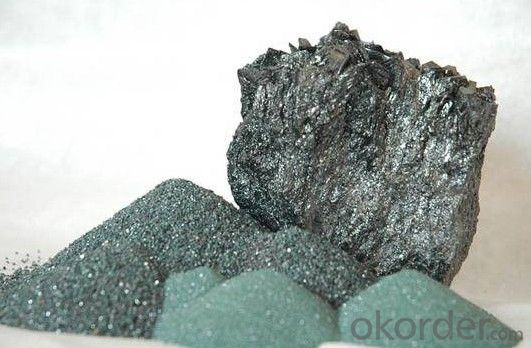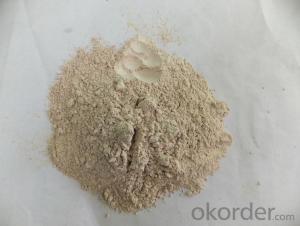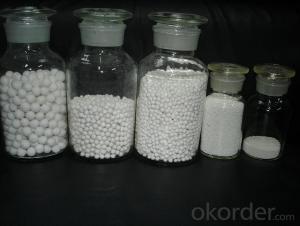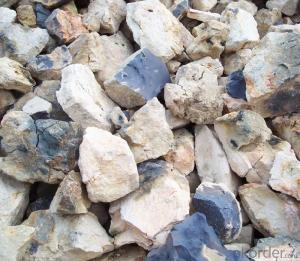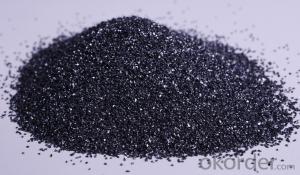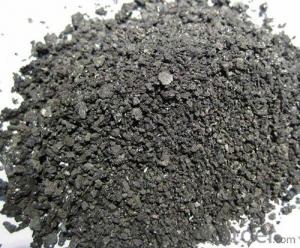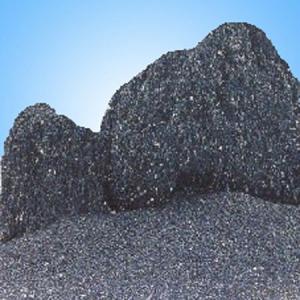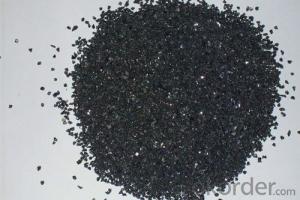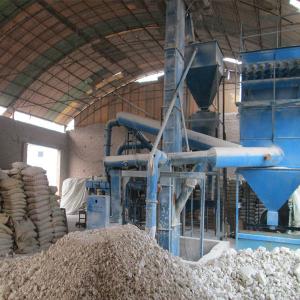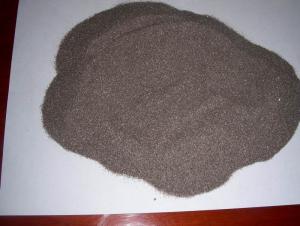Raw Materials for Refractory - Black SIC/Silicon Carbide 10-100mm and Powder
- Loading Port:
- Tianjin
- Payment Terms:
- TT or LC
- Min Order Qty:
- 25 m.t.
- Supply Capability:
- 3000 m.t./month
OKorder Service Pledge
OKorder Financial Service
You Might Also Like
Black SiC/Silicon Carbide 10-100mm and Powder
1.Structure of SIC Description
Black Silicon Carbide is produced with high temperature in a electric resistant furnace from a mixture of quartz sand and petroleum coke.
Black silicon carbide is typically used for working on cast iron ,non-ferrous metals, stone, leather, rubber, and other materials which requires sharp cutting characteristics. The mineral is also used widely as a refractory material and metallurgical additive.
2.Main Features of SIC
Its hardness is between that of fused alumina and synthetic diamond and mechancial intensity of it is also greater than that of fused alumina. It is brittle and very sharp and has a certain degree of electrical and heat conductivity.
3.Main usage of SIC
1.Grinding non-ferrous materials, rock, stone, leather, rubber, finishing tough and hard materials
2.Bonded abrasive tools, lapping and polishing
3.Widely used as a metallurgical additive and refractory material
4.Refractory
4. SIC Images
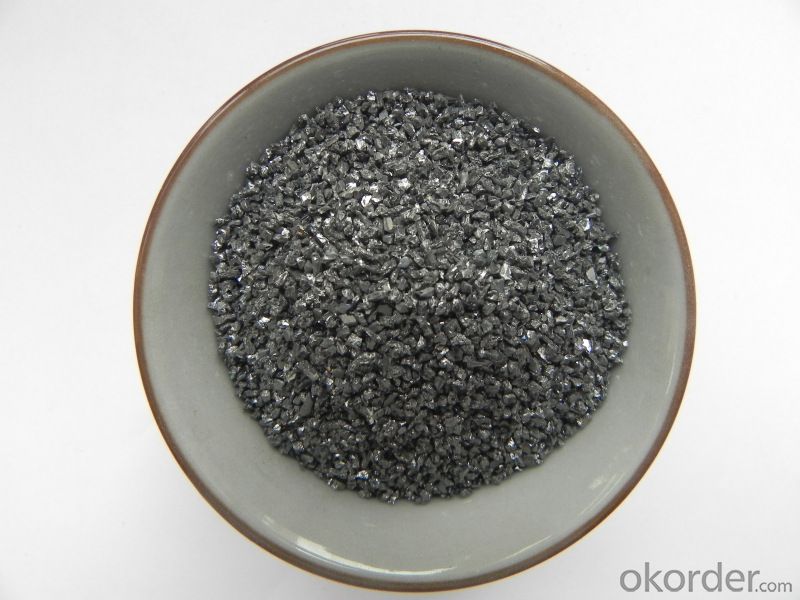
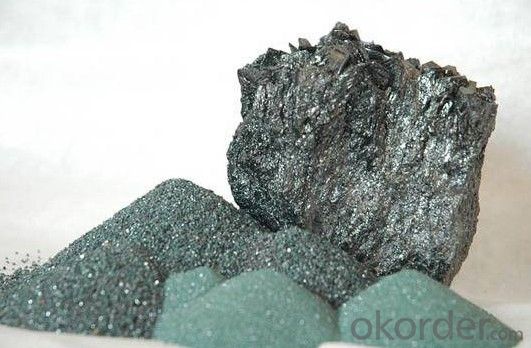
5. SIC Specification
SiC (≥) | Type | Size |
98% | Grit (#) | 7#-80# |
80#-120# | ||
120#-240# | ||
97% | Powder (#) | 80F |
200F | ||
325F | ||
98% | Grit (#-#) | 0-1mm |
1-3mm | ||
3-5mm | ||
7-12# | ||
14-30# | ||
36-70# | ||
90% | Grit (#-#) | 0-1mm |
0-10mm | ||
0-15mm | ||
1-3mm | ||
1-5mm | ||
1-10mm | ||
1-15mm | ||
3-10mm | ||
200F | ||
325F | ||
88% | Grit (#-#) | 1-10mm |
6.FAQ of SIC
1). Q: Are you a factory or trading company?
A: We are a factory.
2). Q: Where is your factory located? How can I visit there?
A: Our factory is located in Ningxia, China. You are warmly welcomed to visit us!
3). Q: How can I get some samples?
A: Please contact me for samples
- Q: Can anyone tell me the requirements of the refractory masonry??
- Refractory materials actually have two functions. The first one is to improve the refractoriness and the second one is to improve the body plasticity of refractory materials.The higher the aluminum content is, the better refractory it will be. Of course, the content of aluminum in refractory materials can not be impoved only by using kaolin. Such raw materials that contain more aluminum as bauxite chamotte should be used as framework.So the content of aluminum in kaolin does not need to be too high and more than 38% of aluminum is enough. However, the viscosity should be taken into account. It will be better if the viscosity is better as the extra bentonite do not need to be added.The refractoriness that is is above 1400 degree is enough.
- Q: How many refractory materials does the annual output of 1 million tons of coke oven require?
- Refractory materials are expensive, and any refractory accident will lead to a considerable waste of production time and equipment, and sometimes even the product itself. The type of refractory material will also affect energy consumption and product quality. Therefore, it is very important to select the refractory material which is most suitable for various applications. While the economic benefits have great influence, refractory material most suitable for some applications need not be used for materials, but can achieve a balance between material installation cost and performance, this balance is not fixed, but with the introduction of new technology or new refractory materials and changing. History has proved that unremittingly seek metallurgical process more reasonable and development, greatly promoted the development of refractories, quickly resolve these problems has become the modern refractory steel technology development is an important element. The content of this article is to discuss a number of factors including these issues and to provide information on how to solve them.
- Q: What high-molecular polymers can be used as fire-resistant material binder?
- Organic silicon
- Q: Who can introduce the external wall thermal insulation materials fire rating regulations?
- According to public fire-fighting [2007] No. 182, the contents of the notification on the implementation of a number of issues of national standards GB8624-2006 "building materials and products combustion performance classification", since there is large differences between the new version of the standard GB8624-2006 and the old version of GB8624-1997 in the principle, hierarchical structure and test methods. According to the cintent of notification, in order to ensure a smooth transition between the old and new standards, the current national standard "Fireproof? Specification of Building Interior Decoration?Design" GB50222, "fire?safety?rules of tall civil buildings design" GB50045, "Fireproof? Specification of Building Design" GB50016 have not completed the relevant amendments, the new classification method of GB8624-1997 and GB8624-2006 can be used for temporary reference in terms of combustion performance of materials . From GB8624-2006 standard implementation, the classification of combustion performance is too granular, which do not match to the actual construction of the current project in our country. Therefore, the relevant departments carry on the 3rd amendment for the GB8624-2006 standards, namely GB8624-2012, and it will be released on December 31, 2012 and implemented on October 1, 2013. The combustion grading requirements in the standard: Level A is non-combustible materials (products); level B1 is nonflammable material (products); level B2 is combustible materials (products); level B3 is flammable materials (products).
- Q: I would like to ask a friend that how much is the fire endurance of level A fireproofing glass?
- fireproofing glass is mainly control the spread of fire or smoke insulation, and is a measurable fireproofing material, the fireproofing effect is evaluated by the fire resistance. It is through a special process and treatment, and it is a special glass which can maintain its integrity and thermal insulation in the specified fire resistance test. Original glass of fireproofing glass can be used float flat glass, and composite fireproofing glass also can use monolithic fireproofing glass.
- Q: Manganese steel belongs to refractories
- Material wear and other harsh working conditions, extrusion, there will be work-hardening phenomenon rapidly on the surface. The most important feature of manganese steel is that it is not refractory under a strong impact, and under extrusion conditions, part of it will be fractured. The main form of damage is wear and consumption: It is a kind of inorganic non-metallic material whose refractoriness is not lower than 1580 ℃, mainly used to endure impact. Manganese steel is a kind of high strength steel, which is free of deformation, so that it can remain austenite good toughness and ductility at heart while keeping good wear resistance at the same time on hardened layer. Refractories are
- Q: Which kind of external wall fire barrier zone material is better?
- I recommended foam cement and particulate thermal insulation composite waterproof material, which is fire isolation area product, which uses surface of vertical?plate arranged fiber technology to make the compressive?strength in the vertical direction up to above 80KPa. At the same time, under the conditions of both exterior heat insulation and effects of humiture in the long-term, it can still maintain the non-aging performance of various aspects, and safety (reliability), fire resistance and excellent durability.
- Q: Which refractory is better for building 1500 degree kiln ?
- The top and wall use alumina hollow ball brick. If it is cubic kiln, the kiln bottom should use heavy corundum brick. If it is continuous kiln, burning zone should use alumina hollow ball brick, burning zone seal and kiln car face brick. If it is pit furnace, curved seal should use heavy corundum brick, and furnace wall and top should use alumina hollow ball brick. That depends on what kind of kiln it is. Curved seal and kiln car should use heavy corundum brick. You can add me friends to have further talks.
- Q: How to classify fire resistance rating of brick-concrete structure?
- In order to ensure the safety of the building, the fire protection measures must be taken to make it have a certain degree of fire resistance, even if there is a fire, it will not cause too much damage. According to the national conditions of our country, and in the light of other countries standards, < high-rise civil building fire protection design specification > defines fireproof rank of high-rise civil buildings into level one and two; < code for fire protection design of buildings > divides the rank into level one, two, three, four, level one is the highest level, level four is the lowest. Besides that the minimum fire resistance of the building component is specified, buildings of fire resistance rating also specified requirements for combustion performance. Because the component with the same fire resistance limit is different, it is different in the fire.According to our country national standard < building design fire protection code >, the fire resistance rating of the building is divided into four levels. The fire resistance of a building is determined by the combustion performance and fire resistance of building components (such as beams, columns, floors, walls, etc.). Generally speaking, the fire resistance building of level one is a mixed structure of reinforced concrete structure or a mixture of brick wall and steel concrete structure; the fire resistance building of level two is a mixed structure of steel truss structure, reinforced concrete column and brick wall; the fire resistance building of level three is brick-wood structure made of wood roof and brick wall; the fire resistance building of level four is combustible structure which is composed of wood roof and non-combustible wall.
Send your message to us
Raw Materials for Refractory - Black SIC/Silicon Carbide 10-100mm and Powder
- Loading Port:
- Tianjin
- Payment Terms:
- TT or LC
- Min Order Qty:
- 25 m.t.
- Supply Capability:
- 3000 m.t./month
OKorder Service Pledge
OKorder Financial Service
Similar products
Hot products
Hot Searches
Related keywords
